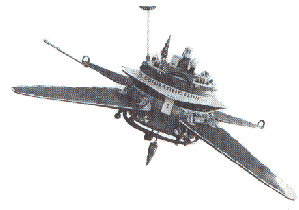
Prognoz 7 was launched into a highly elliptical orbit
on 30 October 1978. The orbit ranged in radius from 200,000 km to 500 km above
the Earth's surface, at an inclination of 65 degrees. The orbital period was
about 4 days. The satellite was spin stabilized, with a spin period of ~120
seconds. The spin axis pointed at the Sun. The mission ended in June 1979.
Prognoz 7 was part of the French-Soviet collaboration SIGNE 2. The SIGNE 2
project consisted of French-built gamma-ray detectors on the Soviet satellites
Venera 11, Venera 12, and Prognoz 7. These 3 satellites then formed an
interplanetary gamma-ray burst triangulation network. Two features made this
program unique in its time: it was the first time that identical detectors had
been used simultaneously for gamma-ray burst studies on separate spacecraft
over interplanetary distances, and the experiments used the largest dedicated
gamma-ray burst detectors put into orbit.
Two collimated, lateral detectors were used primarily for the observation of
discrete sources, while the upper, omnidirectional detector was used for
bursts. The axis of the upper detector is parallel to the satellite spin axis.
The axis of the lateral detectors was 9.5 degrees away from the spin axis, in
order to create a roll modulation for discrete source observations. The
dedicated gamma-ray burst detector, i.e. the upper detector, faced in the
direction of the Sun. It was a 4.5 cm radius by 3.7 cm thick NaI(Tl) crystal,
surrounded by an 8 mm thick plastic anticoincidence jacket. The crystal and the
plastic were viewed from the side by photomultipliers.
The gamma-ray burst detector operated in low time resolution "waiting" modes
in the absence of a burst; low energy resolution spectra and higher energy
resolution calibration spectra were transmitted in this mode. Typically, the
data were accumulated into 163.8 s time bins, 1-31 energy channels. Detection
of a burst triggered the storage of high time resolution count rates and
spectral data. The trigger criterion was an excess count rate 8 sigma above
normal in a 250 ms interval. The maximum time resolution was 1/512 s. The
energy ranges examined for burst detection ranged from 50-270 keV to 600-3000
keV, depending on the detector mode. During a burst, there were 1-6 energy
channels used, and, for Prognoz 7 and a "typical" burst, the nominal energy
range was 80-1000 keV. The total data rate for the Prognoz 7 experiment package
was 6 b/s.
The experiments in the 3 satellite network were live for about 90% of the
period September 1978-June 1979, detecting 30 confirmed gamma-ray bursts.